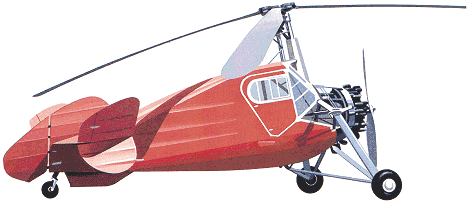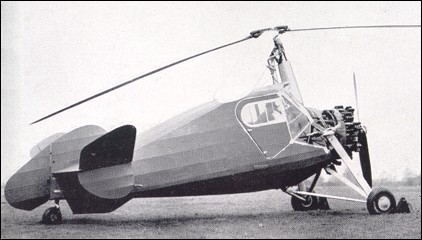|
|
Rotating-wing aircraft and helicopters hold the interest of many in the world of aviation, and their unique operational uses are beyond dispute, but the problems and limitations connected with their design and manufacture are such that, up to the present, little progress has been made in producing large commercial machines on these lines.
In 1934, however, the Westland design staff, in co-operation with Senior Cierva, of the Cierva Autogiro Company, produced a large five-seat cabin autogiro, powered with a 600hp Armstrong Siddeley Panther engine. It was much larger and heavier than anything of its kind previously attempted. The Cierva Company was responsible for the rotors and rotor mechanism, the direct control system being employed, while the airframe was designed and built by Westland.
Test of this machine, which was known as the C.29 Autogiro, disclosed vibration problems with the rotor system, which could not be immediately solved. In the circumstances it was decided to shelve this particular design, until further experience had been gained with other experimental autogiros, but the untimely death of Senor Cierva ultimately prevented development of this work.
TYPE: Experimental five-seat cabin autogiro.
POWER: One 600hp Armstrong Siddeley Panther fourteen-cylinder double-bank air-cooled radial engine.
CONSTRUCTION: The fuselage was of square-section steel and duralumin tubing, arranged in the characteristic Westland style, with composite stringers and formers to give a deep oval section. The fabric-covered tailplane and vertical and oblique fins were built up of duralumin tubing and pressings, the aerofoil section of the port half of the tailplane being inverted, to offset airscrew torque effect. The seating in the roomy cabin was arranged in the 2-3 plan, as in a car. A.H.Lukins "The Book of Westland Aircraft", 1943

This experimental five-seater autogyro, constructed in Duralumin tubing, was designed in collaboration with Juan de la Cierva. It was fitted with a 14-cylinder double-bank air-cooled radial engine, and its rotor head was of the direct-control type.
This aircraft never flew. Ground tests revealed a large amount of ground resonance, but before this could be rectified de la Gierva died and the work was abandoned. P.Lambermont "Helicopters and Autogyros of the World", 1958
The Westland C.29 experimental autogyro derived from a Cierva model. It had four seats in an enclosed cabin. The project was abandoned, owing to serious resonance problems. G.Apostolo "The Illustrated Encyclopedia of Helicopters", 1984
 |
Westland-Cierva C.29
|
 |
Westland-Cierva C.29
|
| Technical data for Westland-Cierva CL.29
Rotor diameter: 15.23m,
length: 11.58m,
height: 3.88m,
loaded weight: 2268kg,
empty weight: 1461kg,
speed: 257km/h,
landing speed: 34km/h,
rate of climb: 475m/min
|
Warning: mysqli_connect(): php_network_getaddresses: getaddrinfo for mysql5.zone.ee failed: Name or service not known in /data03/virt15346/domeenid/www.aviastar.org/htdocs/helicopters_eng/cierva_c-29.php on line 117
Fatal error: Uncaught mysqli_sql_exception: php_network_getaddresses: getaddrinfo for mysql5.zone.ee failed: Name or service not known in /data03/virt15346/domeenid/www.aviastar.org/htdocs/helicopters_eng/cierva_c-29.php:117
Stack trace:
#0 /data03/virt15346/domeenid/www.aviastar.org/htdocs/helicopters_eng/cierva_c-29.php(117): mysqli_connect('mysql5.zone.ee', 'd14657sa18989', Object(SensitiveParameterValue))
#1 {main}
thrown in /data03/virt15346/domeenid/www.aviastar.org/htdocs/helicopters_eng/cierva_c-29.php on line 117
|





